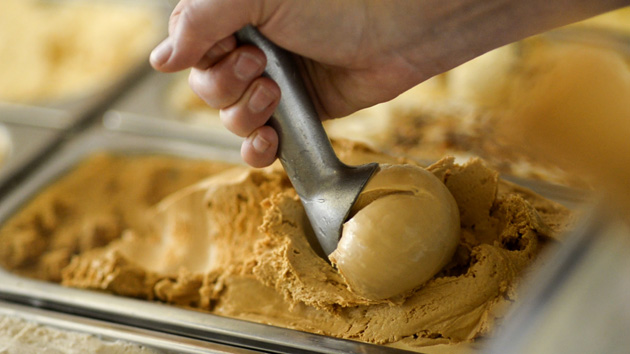Bi-Rite Creamery in San Francisco. (Photo: Paige Green)
American ice cream shop menus are reflections of their owners. Some –
like the list at the brand new Odd Fellows in Brooklyn – change daily
based on the whims of the creative geniuses in the kitchen. Others, like
the tried-and-true flavors at Wilton Candy Kitchen in Iowa, haven’t
changed a lot in the century and a half they’ve been serving scoops.
We’ve rounded up the best spots to buy a cone or a cup this year.
Some are old; some are new. Some own their own milk cows and others are
pouring beer in the batter. Really want your taste buds blown? Amble up
to a Coolhaus truck and partake in a Chicken & Waffles-flavored ice
cream sandwich before summer’s over. Yes, you read that right.
Bi-Rite Creamery & BakeshopSan Francisco
Serving the vibrant and varied Mission neighborhood in San Francisco,
Bi-Rite focuses on ripe organic fruit, local cream and milk from a
nearby organic dairy, and sustainable practices like compostable cups
and spoons. Unlike other chilly, white-tile-decorated parlors, this one
features warm, rough wood accents, sourced from Marin.
The flavors trend creative, like their Balsamic Strawberry, made from
fresh berries roasted in organic balsamic vinegar. They are then pureed
and mixed with the cream base and hit with a second, healthy dose of
vinegar for a tart and sweet taste that’s put Bi-Rite on the map. If
strawberries aren’t your thing, we suggest their peanut-brittle-filled
Coffee Toffee ice cream, with java sourced from Ritual Roasters just
down the road.
“This all started when my husband bought me a Jersey cow for
Christmas one year,” muses owner Karen Deconna. “I got this cow, and I
didn’t realize that they gave five gallons of milk a day.
When the gorgeous corner space went up for rent at the old train
depot in town, it seemed destiny to bring her ice cream to the masses.
Grab a scoop of her frozen custard ice cream seasonals – like the fresh
blueberry or the mid-summer mango – and rest assured you are getting
ultra fresh. “I wake up and milk our six cows every day, and that’s
where the ice cream starts,” she says.
There’s a wide porch beyond the sunny shop windows, rocking chairs
and a view of a pasture beyond. Jersey Creamery is a bucolic testament
to the way ice cream was meant to be experienced.
Named a “favorite” recently by Saveur magazine, this quirky shop is
run by cousins Kim and Tyler Malek. At Salt & Straw, they will put
anything in their ice cream, including olive oil. Arbequina olive oil, to be exact.
You could also opt for their Smoked Hefeweizen, their Fermented Pear
& Fudge, or a double scoop of their Pear & Blue Cheese. Rest
assured, they’ve got a Pacific Northwest attitude when it comes to
sourcing ingredients. Everything is local, organic when it can be,
sustainable if possible and farm-to-cone fresh at all times. A recent
collaboration with Portland-based breweries means you can ship your
buddies (or yourself) a great six-pack of beer-laced ice creams.
Odd Fellows Ice Cream Co.(Photo: Liesl Henrichsen/Photopink)Brooklyn, N.Y.
The youngest spot on the list, Odd Fellows is a collaboration by
culinary icon Sam Mason, and husband-and-wife team Holiday and Mohan
Kumar. They opened their spot in June, but despite the tender age, it’s a
bit of warfare to get inside on a sunny day. “We usually have a line,
and we sell out of some flavors in a few hours,” says Mohan Kumar.
Sam Mason whipped up a Chorizo Caramel Swirl one
morning, with chorizo flavor infused into the cream and the caramel.
Then there was the Manchego Cheese with caramelized pineapple and thyme
flavor. Think what you want about the Ice Cream Jesus picture inside,
but you have to agree the smell is heavenly.
 (Photo: Time Out NY / Jolie Ruben)
(Photo: Time Out NY / Jolie Ruben)
CoolhausLocations nationwide
Launched from a lone ice cream truck in
Los Angeles
in 2009, Coolhaus is now prepared to dominate. Let’s put it this way:
if the Zombie Apocalypse ever happens and the zombies are somehow
deathly allergic to
really delicious ice cream, Coolhaus has you covered.
They have 10 trucks spanning America, from New York City to
Austin and
Dallas,
and an L.A. storefront shop with another on the way. Their menu takes
classic flavors and adds fun twists, like Brown Butter Candied Bacon ice
cream, Peking Duck ice cream, Chicken & Waffles, and Dirty Mint
Julep. They’re also sold in natural markets such as Whole Foods
throughout the country.
What started in 1929 as a full-service dairy just an hour past Fresno
now focuses on pleasing customers with simple, delicious, no-nonsense
ice cream in a handful of flavors and massive presentations.
While the business is trimmed down, the sundaes keep growing in size.
Their “S.O.S.” comes with nine scoops of ice cream, bananas,
strawberries, hot fudge, whipped cream and cherries – all served in a
massive beer goblet. The building is virtually untouched, with a
beautiful pressed tin ceiling and the charms of small-town life. “Most
kids in the town get their first jobs here,” says co-owner Susan
Bowden-Wing.
(Photo: Courtesy of wilton candy kitchen)
Wilton Candy Kitchen Wilton,
Iowa
Chatting with owners Thelma and George Nopoulos is a delightful
experience, no matter what flavor you choose to sample. She’s 81. He’s
93. They’ve owned this joint since 1951, when they put in a new floor, a
ice cream machine and soda fountain. Nothing else has changed. The
place actually opened back in 1860 – the year Abe Lincoln was elected
president – making it one of the oldest in America.
Thelma got her first job at age 10 inside of the Wilton Candy
Kitchen, and she’s seen her fair share of celebrities over the decades.
If you ask her what Gregory Peck ordered, she will tell you with
absolute clarity that it was a grilled cheese sandwich with hot mustard
and a chocolate soda with homemade ice cream.
La Divina Gelateria(Photo: Courtesy of La Divina)New Orleans
In the Crescent City, imbibing plays an all-important part in daily
life. Given the chemistry required to make frozen gelato creamy, it’s
not a simple science to toss booze in the batter. These guys do it with
finesse at three locations in town, and the result is flavors you won’t
find anywhere else on Earth.
In summer, fresh fruit comes
forward in their Peach Amaretto and Peach Prosecco options, and in fall,
definitely request the Turbo Dog Chocolate Sorbetto, which marries
locally brewed Abita Turbo Dog beer with dark Valrhona chocolate. They
also serve Panini sandwiches here, which are maybe a wise idea if you
choose their alcohol-based options.
 The home in Torquay may fall into the sea at any time.
The home in Torquay may fall into the sea at any time.

























